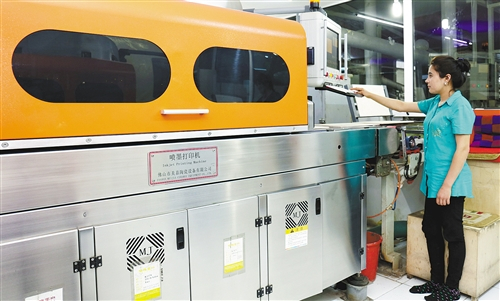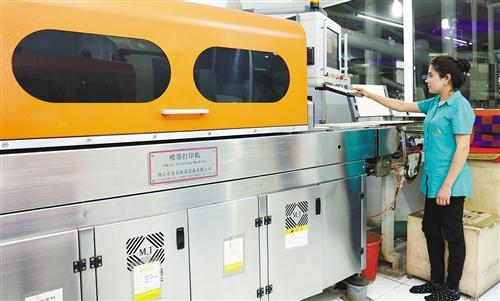
Photo: A staff member works in a ceramic company in the Pengsheng Industrial Park, Sirdaryo state, Uzbekistan, May 8, 2018. The Pengsheng Industrial Park is the biggest non-energy cooperation project between China and the Central Asian country.
BEIJING, June 14 (Xinhua) -- In recent years, Kazakhstan, Uzbekistan, Turkmenistan, Kyrgyzstan, Tajikistan and other Central Asian countries have internally deepened reform, improved business environment and focused on infrastructure construction. Externally, they have paid much attention to enhancing economic and trade exchanges with China and actively participated in the Belt and Road (B&R) construction.
--- Active participants in the B&R construction
Central Asian countries think highly of the B&R Initiative and deem it as a rare opportunity to achieve rapid development. At present, the five Central Asian countries have included cooperation with China into their respective national strategic frameworks.
China is Kazakhstan’s main trading partner and Kazakhstan’s second largest export market and second largest import source. According to the 2018 investment guide formulated by the Kazakh government, Kazakhstan wants to participate in the B&R Initiative, which will create 20,000 jobs and improve the country’s infrastructure in the following five years. The Kazakh government hopes to change the development mode of high reliance on oil and other natural resources, improve railway and highway infrastructure, and promote the development of logistic industry through cooperation with China under the initiative.
So far, China and Kazakhstan have reached agreements on 51 capacity cooperation projects with a total investment of 26.5 billion U.S. dollars. Among them, 12 projects involving 4 billion U.S. dollars have been launched or are about to be launched.
Uzbekistan is a key country on the Silk Road Economic Belt. President Shavkat Mirziyoyev stated that the country will take the opportunity offered by the B&R Initiative to deepen cooperation with China in infrastructure, investment, economy and trade, production capacity, industrial parks and water conservancy.
Infrastructure connectivity is a common concern of many countries in Central Asia. The B&R Initiative has provided opportunities for Central Asian countries to develop roads, railways and other transportation facilities. With funding and technology from China, Central Asian countries have begun to make more use of clean energy such as wind power and solar energy to generate electricity and improve ecological environment. This is conducive to promoting stability in the region and realizing economic prosperity.
Central Asian countries’ active participation in the initiative was praised by both local and international communities. Sanat Kushkumbayev, deputy director of the Kazakhstan Institute for Strategic Studies, said that the Kazakh government plans to improve domestic and cross-border transportation infrastructure, which is similar to the goal of the B&R Initiative in Central Asian countries, that is, to strengthen connectivity between China and Central Asia.
--- Intensified economic cooperation
Central Asian countries have seen intensified cooperation with China in the field of economy and trade. Moreover, their dependence on Chinese market continues to rise.
Kazakhstan regards China as one of the most important trading partners. Statistics showed that the two countries’ trading volume grew 37.4 percent year on year to 18 billion U.S. dollars in 2017. China has become Kazakhstan’s second largest trading partner.
China is Uzbekistan’s second largest trading partner, the largest investment source, the largest cotton export destination, and the largest supplier of telecommunication equipment and soil improvement equipment. Last year, the bilateral trade stood at about 4 billion U.S. dollars, registering a year-on-year increase of 15 percent and accounting for nearly one fifth of Uzbekistan's total foreign trade volume.
China has been Turkmenistan’s largest trading partner for many years. The two countries have stepped up cooperation in infrastructure connectivity, promoted trade facilitation, optimized trade structure, and accelerated the development of high-tech product trade. Last year, the bilateral trade volume between the two countries amounted to about 7 billion U.S. dollars, maintaining a relatively rapid growth.
China is Kyrgyzstan’s largest trading partner, the largest import source and the largest investment source. In 2017, the bilateral trade in goods between the two reached about 5.6 billion U.S. dollars, accounting for 27 percent of Kyrgyzstan’s total foreign trade volume. Kyrgyzstan has made remarkable achievements in attracting Chinese investment in 2017 by improving investment policies and strengthening project promotion. Chinese enterprises’ investment in Kyrgyzstan mainly concentrates in the areas of energy, rubber, plastics manufacturing, non-metallic mineral production, geological exploration and mineral product exploitation.
Strengthening the friendly relationship with China is one of the diplomacy priorities of Tajikistan. The two countries have signed nearly 200 bilateral documents. Tajikistan hopes to export more agricultural products to China and strive to expand bilateral trade volume to 3 billion U.S. dollars before 2020. (By Zhang Yuan, zhangyuan11@xinhua.org)




 A single purchase
A single purchase









